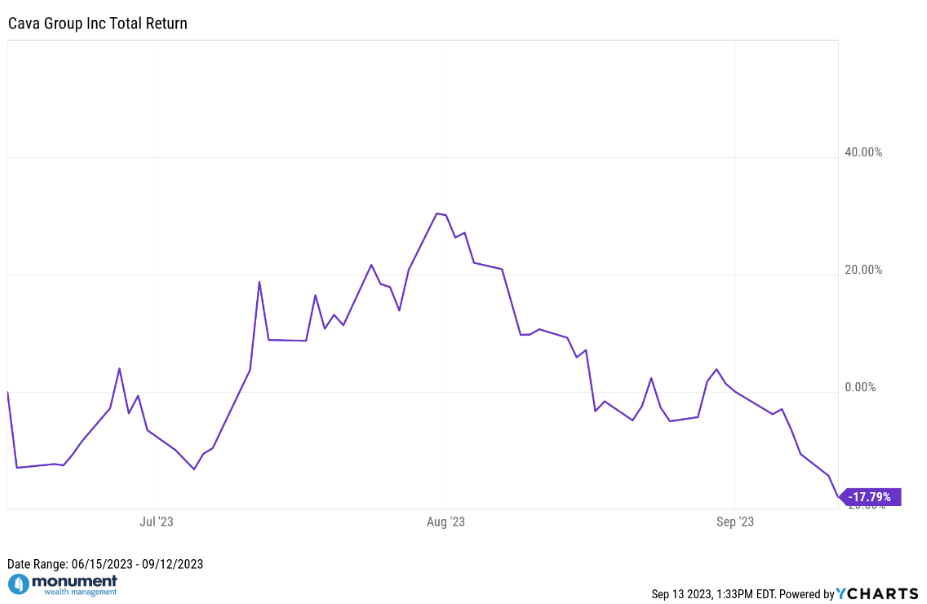Written by: Nate Tonsager
The market has been buzzing with anticipation for computer chip designer Arm Holdings’ initial public offering, or IPO, that happened yesterday, 9/14/23. A lot happens when a company decides to go public and lists its shares on exchanges like the NYSE (New York Stock Exchange) or the Nasdaq. There is an immense amount of background work leading up to listing day, but that’s not what’s important to me. Where I find real value is watching an IPO’s price action after its launch.
A good example is $CAVA. Back in June, I posted on LinkedIn that Mediterranean restaurant chain Cava (ticker: $CAVA) went public and was up as much as +117% during its first trading day. For a variety of reasons, investors piled in to get a piece of its potential future growth even though Cava was still a relatively young and unprofitable company.
Fast forward about 3 months to its close on 9/12/2023, and Cava has roughly a -17.8% total return since it went public. Talk about volatility – both to the upside and the downside. Investors who were chasing the potential outsized gains from this “hot” IPO, could’ve easily been burned after the initial hype faded and there wasn’t enough investor demand to support the elevated price. Without enough buyer demand, the stock price drifted lower below its initial trade price. Meaning, even those investors who got in right away and experienced the rocket ship +117% increase, would be down today if they still are holding onto $CAVA.

Admittedly, 3 months is a very short time period, and the book is not closed on Cava as a company or stock. But this type of price action, while arguably ridiculous, isn’t abnormal for IPOs. This wasn’t the first IPO to have insanely strong performance in its first trading day, followed by selling pressure that pushed the price lower over time. Not every IPO will go through this process, but I am confident that $CAVA won’t be the last.
I can see why so many investors become enamored with IPOs and other highly speculative investments that seemingly offer the opportunity to get-rich-quick. These are home run swings and if you hit one, there is no better feeling in the world. However, with home run swings, comes increased probability of strikeouts, and those can be detrimental to your financial plan’s long-term success. Don’t take home run swings if you aren’t financially stable enough to handle a strikeout.
All too often I see investors making the mistake of being overly obsessed with possible home runs. They sound great in theory but, in my experience, rarely work out. For most people, their allocation shouldn’t be dominated by home run hitters, but instead be filled with doubles hitters. If you’re a baseball fan, I’m talking about investments with a good slugging percentage. Investments that could produce solid (but likely not massive) gains while also hopefully offering lower volatility than those highly speculative investments that sometimes have gigantic gains.
My favorite baseball player to this day is Joe Mauer. He played his whole career as a catcher for his hometown team the Minnesota Twins. He had a career batting average of .306 and 923 runs-batted-in (RBIs) over his 15-year career, but he only hit a total of 143 home runs, or about 12/ per year while he played. Francisco Alvarez, a rookie catcher for the New York Mets, has 23 home runs in just his first 109 major league games this season, but he also has a batting average of .216.
Even without being known as a home run hitter, Joe Mauer was a superstar. He had the best batting average in the majors 3 out of 4 years through the 2006 to 2009 seasons and was the American League MVP in 2009. His success was largely due to his ability to avoid strikeouts and consistently get hits – especially when it mattered most to his team.
So, who would you rather have on your team? The steady, kind of boring player with a better chance of getting a hit? Or the young unknown upstart who’s more likely to crush home runs but also more likely to strike out? Which player you choose says something about your risk tolerance. For me, if it isn’t already obvious, I’d take Joe Mauer’s production almost every time because I value consistency, and normally I don’t need home runs.
My little league coach told me long ago, “Base hits win ball games; not home runs.” I’d argue the same is true for investing. You don’t need insanely high returns (home runs) to have a successful investment strategy or financial plan. For most people, all they need is benchmark or index-like returns year-over-year (consistent base hits) to help them achieve their goals. Said differently, don’t swing for the fences if all you need is a single.
Related: What I Learned on My Recent Visit to Alaska: You Can’t Escape Investor Biases

